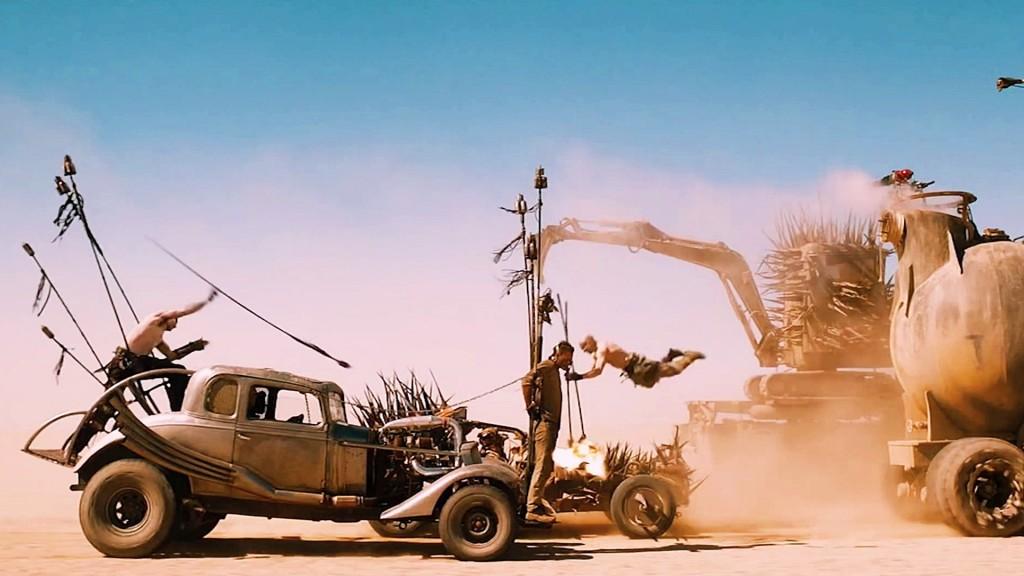Standing next to his makeshift roadster, “Mad” Max Rockatansky is looking out over the arid remnants of what was once Australia, now stripped of life after a massive nuclear disaster. Well, not all life. Coming over the hillside, a caravan of marauders is speeding down into the valley, ready to wreak havoc on any poor soul fighting to survive in the world of “Mad Max: Fury Road.”
The awaited continuation of the beloved “Mad Max” storyline, this fourth installment follows the titular Max as he fights, drives and miraculously avoids death in the blighted, unforgiving hellscape that was once Earth. At first glance, this premise sounds typical of the many blockbusters that hit theaters during the summer season, but “Mad Max: Fury Road” manages to set itself apart. In fact, “Mad Max” casts away much of the melodrama expected in big-budget action films, and instead delivers a concentrated, two-hour dose of blood, flames and explosions that is thrilling, satisfying and most importantly, outrageously entertaining.
Tom Hardy takes on the role of Max, a drifter burdened by guilt over the death of his family. Constantly battling hallucinations of his lost loved ones, he roams the nuclear wasteland struggling to survive. However, as the film begins, any luck Max may have had runs out, and he finds himself prisoner of the War Boys, a band of rebel survivors led by the tyrannical dictator Immortan Joe (Hugh Keays-Byrne). All goes to hell, however, once one of Immortan Joe’s most respected soldiers, Imperator Furiosa (Charlize Theron), goes rogue and steals away with the dictator’s “breeders” — women forced to populate the Citadel, the War Boys’ massive stronghold. Max finds himself along for the ride as the War Boys track down Furiosa, ultimately pitting her, Max and a slew of other survivors against waves of crazed rebels in a massive, vehicular chase.
This high-speed pursuit is, quite simply put, a visual and sensory extravaganza. The makeshift vehicles, vast desert scenery and catastrophic car accidents work together to craft an action film that moves at a breakneck pace. The first clash, for example, rages on and on for almost 30 minutes, delivering to audiences all the havoc they could ever want, and then some. What becomes overwhelmingly clear is that “Mad Max: Fury Road” revels in its balls-to-the-wall style, and the results are a variety of tongue-in-cheek but constantly inspired action sequences.
Despite the constant mayhem, “Mad Max: Fury Road” isn’t all fender benders and flame-throwing guitars. In the brief moments where the combat ceases, the film boasts impressive performances across the board. Hardy’s portrayal as the brooding Max is convincing, as is Theron’s role as the conflicted, yet hopeful, Furiosa. The pair’s characterization is never forced, and the script opts out of lengthy, tell-all monologues for more nuanced moments of development. Furiosa’s sympathetic glances as she begins to witness Max’s internal turmoil or a feeble thumbs-up from Max during combat allows for meaningful development throughout the film.
All of this considered, what may prove the greatest strength of “Mad Max: Fury Road” is its clarity and skill in storytelling. The storyline is well-crafted but never needlessly complex, and overused film tropes like the slow-motion kiss or the happily-ever-after resolution are not present. Instead, the entire dystopian romp is rendered with purpose, free of plot holes and proving that a simple story of survival can offer just as many thrills as the typical maze-like plotlines of recent science-fiction and action films. Nothing in the narrative feels shoehorned in, and the result is a welcome, realistic take on dystopian action.
While it certainly had a mighty franchise to live up to, “Mad Max: Fury Road” proves an extremely able installment to the “Mad Max” mythos. With strong performances, explosive action and an impressive sense of narrative self-awareness, there is much to enjoy in this gritty take on the apocalypse.




















